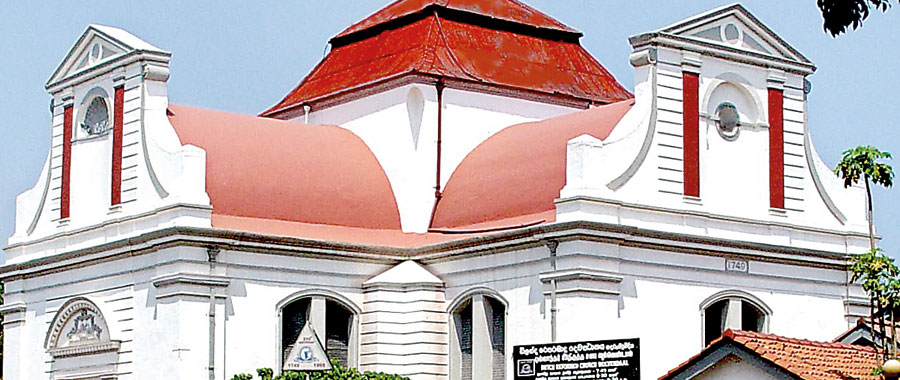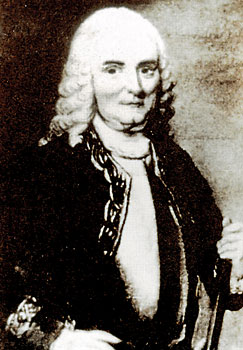Van Gollenesse’s dream
Once, the majestic white-painted Wolvendaal Church towering above the Fort of Colombo, served as a beacon for the approaching sailing ships of the Dutch United East India Company (VOC). Now the building is hidden between large structures of doubtful architecture, ironically with a green painted mosque as a direct neighbour.
Wolvendahl street in Pettah climbs slowly up from Main Street and it must have been quite an undertaking for Protestants of the 18th century to walk uphill in the blistering heat, clad in their formal dresses, attended by slaves carrying their Bibles, spittoons and elaborately carved chairs to attend mass.

Dutch foundation, local flavour: Wolvendaal Church, Pettah
Over the centuries, the Church has evoked much interest and admiration. Sir William Gregory, the English Governor at the end of the 19th century described the Church as: “The Westminster Abbey of Ceylon where so many brave Hollanders lie buried”. But the Church still is shrouded in mystery. Why did a commercial enterprise like the Dutch East India Company build such a large and expensive building when the number of Protestant believers was relatively small despite hundred years of missionary work?Ultimately they came for the cinnamon and not to spread their religion. Trade was their main concern.
When the Dutch under Admiral Gerard Hulft and General Rijcklof van Goens by the 1650s ousted the Portuguese from the Maritime Provinces, the first Predikants (Ministers), medical staff and schoolteachers came to Ceylon to cater to the spiritual and physical needs of the Company’s personnel. The first Dutch Reformed Church was established in Galle in 1642, immediately after the capture of the Galle fort. When in 1658 all Portuguese were finally expelled from the island, the Dutch clergy were in for a big surprise. The energetic missionary work of, in particular, Franciscan friars, who had arrived on the island as early as 1543, had been very successful. The Catholic religion was already professed by some 250,000 Ceylonese, with strong concentrations around Colombo and Negombo. The Dutch took over the dense network of some 160 Portuguese churches and schools, and concentrated on trying to convert their fellow Christians to their Protestant creed.
Why would the Dutch bother to convert people to their specific religion? The real reason was not so much religious, although there were many convinced Predikants, such as Philippus Baldeus who – around 1660 – learned to speak Tamil and worked successfully in the Jaffna area. Initially, the main reason was historic. When they came to Ceylon in the 1640s, the Dutch were still engaged in their long (80 years) war with the Spanish Empire (which at that time also included Portugal). Although the young Dutch Republic had barely escaped total destruction by Spanish mercenaries, the war gave them to opportunity to take over the Portuguese colonies in the East by force.And indeed, they were very successful.
During the first 50 years of their presence in Ceylon the Dutch tried to introduce Protestantism the hard way. They invoked a clause the “Statute of Batavia”which decreed that in the Dutch settlements in Asia only the Reformed Religion would have the status of a public religion. Severe regulations were published against conducting Catholic services and heavy fines were imposed for taking in wandering priests. As to be expected, this policy ended in failure. The Portuguese were able to recruit and train many native priests in nearby India for service in Ceylon. The Dutch could not distinguish them from the local population, let alone arrest them. The few that were caught were put on board a returning VOC vessel on its way to Europe.

Governor Van Gollenesse
Muddling through
In the beginning of the 18th century, the Dutch Governors relaxed their anti-Catholic behaviour. Being practical people, they realised very well that they had to live with the situation and make the best of it. Moreover, Buddhism, Hinduism and the Muslim religion were also strong on the island. These religions were not obstructed in any serious way. The Dutch never destroyed Buddhist temples and places of worship, which were numerous in the Maritime Provinces. On the contrary the famous temple complex of Kelaniya near Colombo, which was demolished by the Portuguese, had been restored in the Dutch period with full cooperation of the Government in Colombo.
However, some restrictions remained. There was a regulation (Plakaat) stating “that no native could be raised to the rank of Mudaliyar (high Government official) or admitted to any employment under the Government, without subscribing to the Helvetic Confession and also professing to be a member of the Dutch Reformed Church”. In practice, many high Sinhalese and Tamil VOC officials could be seen on Sundays in the Dutch Reformed Church while at home they were Buddhists or Hindus. This was confusing to the Dutch but they realised that they had to compromise.
Most Dutch Governors of Ceylon were decent men and believed that persecution of fellow Christians as a means to further the Protestant Religion was doomed from the start. Their view was that the main reason the Ceylonese were reluctant to join the Reformed Church, was because they “…do not have the opportunity to hear the Gospel in their own language”. Therefore the Predikants were advised to concentrate on language studies while the Governor’s stated policy was “…to nominate more local persons as Predikants, who will preach in the Sinhalese and Tamil languages”.
One of the most intelligent of them was Gustaaf Willem, Baron van Imhoff, a nobleman of German descent who was Governor in Ceylon from 1736 to 1740 before becoming Governor General of all Dutch East Indies. He not only strongly supported the higher education of indigenous youth at the Seminary in Colombo (currently the Dutch Period Museum located in Prince Street), but also took the initiative to build the Wolvendaal Church.
The seminary’s primary objective was the training of Ceylonese preachers. The curriculum was almost entirely Western. Latin and Greek were also introduced in the lower classes because the medium of instruction in the higher theology classes was Latin. When Baron Van Imhoff visited the Seminary in 1740, nothing pleased him more than the perfect manner in which Latin and Greek were imparted to the younger pupils. Some of the students performed so well that the VOC undertook the cost of sending them to complete their studies in Holland. Two of the best known students were Willem Jurgen Ondaatje (a forefather of famous Sri Lankans Michael Ondaatje and Sir Christopher Ondaatje) and Henricus Philippus Panditharatne, son of the Maha Mudaliyar for the Dutch territories. Both became native Predikants with the same status as the Dutch born pastors.
The man who was finally responsible for the construction of the Wolvendaal Church was Van Imhoff’s friend and successor Julius Valentijn Steijn van Gollenesse. He succeeded in organising the necessary funds although it took the High Government in Batavia some twelve years to finally approve the construction.
The construction of the Church started in 1749, the date which can be found above the Church’s main entrance. Not much is known about the construction. The official records of the Wolvendaal Consistory (church council) do not make any mention of the progress during the entire eight-year construction period.
Van Gollenesse had very specific about how the church was to be. From the outset he wanted the church to be used for the local population. Preaching in the Church should not be conducted in Dutch but in Sinhalese, Tamil and Portuguese.
Dutch historian Wietse Tolsma, who wrote in 1981 an excellent doctoral thesis on the Wolvendaal Church under the poetic title “Alseenhutje inden wijngaard – Like a cottage in the vineyard”, assumes that the real reason to build the Church was more a matter of prestige than necessity. The local congregation was certainly not large enough to fill the one thousand seats which were available in the new building. The majestic and monumental church might in his opinion well have been a veiled invitation of the Governor to Catholics to join, a statement of strength…..
Mother Church of the Burghers
In 1796 the British occupied the Maritime Provinces of Ceylon. A year earlier, the French had invaded Holland and established the so-called Batavian Republic. Ceylon became a British Crown Colony in 1802, after the Peace of Amiens between England and France, where the French did nothing to protect Dutch interests in Ceylon. Finally, some 3000 former VOC officials known as “Company Servants” and “Burghers” (which also included citizens of Portuguese, German, French, English and Polish ancestry) opted to remain on the island while accepting the political changes and took the Oath of Allegiance to King George III of England.
During the 19th and most of the 20th century, Wolvendaal Church became the “Mother Church” of the Dutch Burgher community. Towards the end of the 19th century, Church membership started to broaden with separate Sinhala and Tamil congregations. On June 3, 1892 the Consistory at Wolvendaal decided to revive mission work amongst the Sinhala speaking and Tamil speaking population.The first service in Tamil in the Wolvendaal Church was held on January 8, 1927 and has continued since.
Today, Wolvendaal Church besides being a protected monument and frequently visited by tourists – still functions as a church. Enter the church on a Sunday morning, and you will see the ancient pews occupied by many local church members. The pews stand on elaborately carved tombstones which cover most of the floor of the Church. Few realise that below their feet is a vault containing the coffins of five Dutch governors – among them Lubbert Jan, Baron van Eck who successfully conducted the war against the Kandyan Kingdom in 1762, Iman Willem Falck, the most successful of all Dutch Governors, who ensured thirty years of peace in Ceylon, as well as many other outstanding figures.
The remains of the founder of the Wolvendaal Church, Van Gollenesse, are not there. He died in Batavia, four years after he left Ceylon. But where ever he is, he must be smiling, looking down on the large congregation, listening to the Tamil Predikant, hearing songs in Sinhala.
It took some time, but his dream came true.
Follow @timesonlinelk
comments powered by Disqus


